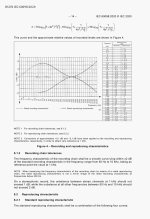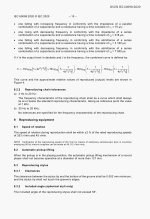Hallo Nick,
Just a few questions:
It’s possible to reduce S/N by 3 to 5 dBA by synthetical cooling, but what is the sense of having a S/N of more than 75dBA, already way above the LP’s surface noise ?
It’s possible to extend the FR beyond 20Khz by adding a von Neumann zero, but what’s the effect on the perceived sound since nobody can hear that high despite some very controversial papers.
Why does none of the top manufacturers add this zero.
And why do you suggest that this is real content instead of just harmonics produced by the Cart itself.
Hans
Just a few questions:
It’s possible to reduce S/N by 3 to 5 dBA by synthetical cooling, but what is the sense of having a S/N of more than 75dBA, already way above the LP’s surface noise ?
It’s possible to extend the FR beyond 20Khz by adding a von Neumann zero, but what’s the effect on the perceived sound since nobody can hear that high despite some very controversial papers.
Why does none of the top manufacturers add this zero.
And why do you suggest that this is real content instead of just harmonics produced by the Cart itself.
Hans
Well, there never was a Neumann pole and hence no need to correct for it, according to this resource : https://pspatialaudio.com/neumann_pole.htmIt’s possible to extend the FR beyond 20Khz by adding a von Neumann zero, but what’s the effect on the perceived sound since nobody can hear that high despite some very controversial papers.
Why does none of the top manufacturers add this zero.
We'd probably need to look a surface noise spectra rather than integrated levels (with weighting even) to see what really happens in the important region above 2kHz or so and whether an electrically cold load resistor has advandages (as it reduces thermal noise in that region). Also, exactly for the purpose of judging surface noise, the amp should be at least 10dB better, preferably 20dB to have some margin.It’s possible to reduce S/N by 3 to 5 dBA by synthetical cooling, but what is the sense of having a S/N of more than 75dBA, already way above the LP’s surface noise ?
I agree, but isn’t Nick adding this zero to his phono preamp thereby lifting the spectrum above 20KHz by 20dB/dec ?Well, there never was a Neumann pole and hence no need to correct for it, according to this resource :
Surface noise is perfectly white above a few hunderd Hz and will of course be processed by the Riaa curve.We'd probably need to look a surface noise spectra rather than integrated levels (
And yes, a cold load resistance reduces the Cart+Amp’s noise at the upper frequency range.
But with modern components it’s very easy to achieve >75dBA S/N making such addition rather over the top.
My point is: is to be expected that by technically increasing properties beyond certain logical limits also increases the perceived sound quality?
Hans
Well, nobody knows for sure. The electrically cold resistor's noise benefit is a good example of what could be tested in a DBT as a simple switch is enough to defeat it, with no other change to the signal path. Say you have increased the physical resistor to 20x 47k (47k + 898k), you simply short the bottom end of the top 47k resistor to ground.My point is: is to be expected that by technically increasing properties beyond certain logical limits also increases the perceived sound quality?
And as mentioned, to be able to measure/evaluate surface noise we need a preamp that reduces noise to the absolute minimum (also applies to using an MC cartridge for that).
The cost and effort for the electrically cold resistor is very reasonable so why not implement it?
I have done that and can confirm that noise is perfectly white beyond a few hundreds of Hz.And as mentioned, to be able to measure/evaluate surface noise we need a preamp that reduces noise to the absolute minimum (also applies to using an MC cartridge for that).
Surface noise is easy to measure with a flat preamp without Riaa.
With 75dBA S/N, Preamp+Cart noise is ca. 20dB below surface noise, more doesn't improve anything.
A preamp with 75dBA S/N is dead silent with the PU arm in the air.
Because less is more, the cold resistor circuit will inevitably add some of it's own signature to the signal.The cost and effort for the electrically cold resistor is very reasonable so why not implement it?
Hans
I guess the AES has now incorporated a "Neumann constante" into their RIA specs. For sure there was no official pole, but a indirect one by the physics of the cutter heads
Just my 2ct
Just my 2ct
The objection was to that dubious claim of a single pole at 50kHz which would indeed affect FR around 20kHz. According to the resource I've linked to a 2nd-order Butterworth lowpass at 50kHz was actually used which does quite a bit better with respect to its impact on FR (mag and phase).I guess the AES has now incorporated a "Neumann constante" into their RIA specs. For sure there was no official pole, but a indirect one by the physics of the cutter heads
Just my 2ct
I guess the AES has now incorporated a "Neumann constante" into their RIA specs. For sure there was no official pole, but a indirect one by the physics of the cutter heads
I would like to draw your attention to another part of the spectrum, namely the lower frequencies (7950 uS), which have been accepted as a mandatory part of phono preamplifiers for all CENELEC countries since 2020. See paragraph 8.2.1 of the current IEC 60098:2020 standard (attached). IMHO 7950 uS is much more important ammendment than Neumann pole.
Attachments
Last edited:
Hallo Nick,
Just a few questions:
It’s possible to reduce S/N by 3 to 5 dBA by synthetical cooling, but what is the sense of having a S/N of more than 75dBA, already way above the LP’s surface noise ?
the answer is simple: I use the same phonopreamp circuit both for MM and MC carts, the difference is only one feedback resistor (18 Ohms instead of 180). The noise is only 1.8 dB more than in Weinberg Paralleled Complementary Phono Pre (ZTX851/ZTX951 x 3 + a lot of megafat electrolytics). See detailed info here https://www.patreon.com/posts/su-xxi-v-8mc-vs-71640368 or English version here [ https://www.patreon.com/posts/pros-and-cons-mm-87586740 ]
Last edited:
Sorry Nick
That wasn’t an answer to my question and the link you provided is locked, I don’t intend to pay to getting access.
Hans
That wasn’t an answer to my question and the link you provided is locked, I don’t intend to pay to getting access.
Hans
OK, - if I have a circuit [ freely here https://www.diyaudio.com/community/...ono-stage-85-dba-sn-ratio.387375/post-7662350 ] of universal MM\MC phonopreamp consisting of two modern field-effect and 5 bipolar transistors without transfo and electrolytics at all, then do I need to worsen the circuit to get worse noise and THD ?Sorry Nick
That wasn’t an answer to my question "but what is the sense of having a S/N of more than 75dBA"
Dear Nick,
As I mentioned it’s very easy with modern components to achieve better than 75dBA S/N including Cart.
But at the same time when everything above 75dBA can be regarded as bringing no single additional benefit whatsoever, while already being way above the LP’s surface noise, there doesn’t seem to be any thinkable reason to add a synthetic cooling circuit as you mention in your documentation to even further increase S/N to above 80dBA.
That was the input for my question to you.
Technically possible but seemingly of no use,
Hans
As I mentioned it’s very easy with modern components to achieve better than 75dBA S/N including Cart.
But at the same time when everything above 75dBA can be regarded as bringing no single additional benefit whatsoever, while already being way above the LP’s surface noise, there doesn’t seem to be any thinkable reason to add a synthetic cooling circuit as you mention in your documentation to even further increase S/N to above 80dBA.
That was the input for my question to you.
Technically possible but seemingly of no use,
Hans
my phono preamp has "passive cooling" scheme = just replacing the 47 kOhm input resistor with a 150 kOhm input resistor. Is it difficult? - no. Effective - yes.there doesn’t seem to be any thinkable reason to add a synthetic cooling circuit as you mention
O.K. I got the impression from earlier readings that you applied active synthetic cooling.
But when you only replaced the 47K//XXpF for 150K//25pF I wouldn't call this passive cooling, but it's a matter of terminology.
And yes, with a very low noise preamp this can increase S/N by 3 to 5 dBA depending on the used Cart.
Question answered.
Hans
But when you only replaced the 47K//XXpF for 150K//25pF I wouldn't call this passive cooling, but it's a matter of terminology.
And yes, with a very low noise preamp this can increase S/N by 3 to 5 dBA depending on the used Cart.
Question answered.
Hans
Then don't consider yourself above others, open access to your MC phono here https://www.diyaudio.com/community/threads/hans-polak-mc-phono.415597/ or may be I ask a jan.didden ? ;-)the link you provided is locked, I don’t intend to pay to getting access.
Ha, ha, you know that Jan Didden has published this article that I wrote for his Linear Audio magazine.
He alone holds the copyright, so ask him for a copy.
I don’t have any further arrangements with Jan.
Hans
He alone holds the copyright, so ask him for a copy.
I don’t have any further arrangements with Jan.
Hans
Interesting facts - I have already written about this topic 😉.But when you only replaced the 47K//XXpF for 150K//25pF I wouldn't call this passive cooling, but it's a matter of terminology.
And yes, with a very low noise preamp this can increase S/N by 3 to 5 dBA depending on the used Cart.
Question answered.
The 150kOhm resistor in question is treated no differently by the surrounding air than any other component on the print. It is not cooled in any particular way - because nothing tricky happens, Nick calls this passive for advertising purposes.
Ideally, the SNR can increase by a maximum of 3.65dB. Why this is the case is obvious - here one can twist and turn until doomsday.
kindly,
HBt.
I do not understand how he can holds copyright of your circuit diagram . In almost 20 years of my tenure as editor-in-chief of Radiohobby magazine [ https://www.youtube.com/playlist?list=PLu1Wtw8bW_xjWNlh8FoJh7mfw3hRWOYYY ] , I have never appropriated the rights to other people's designs.He alone holds the copyright
This seems very useful if you place the preamplifiers right at the end of the tonearm inside your turntable, isn' t it?
That's exactly what Nick S. is all about.
And that is also absolutely correct, namely the best way for an MM system.
This point is completely undisputed.
- Status
- Not open for further replies.
- Home
- Source & Line
- Analogue Source
- JFE2140/OPA192 jFET/MOS phono preamp with "tube" THD spectrum

